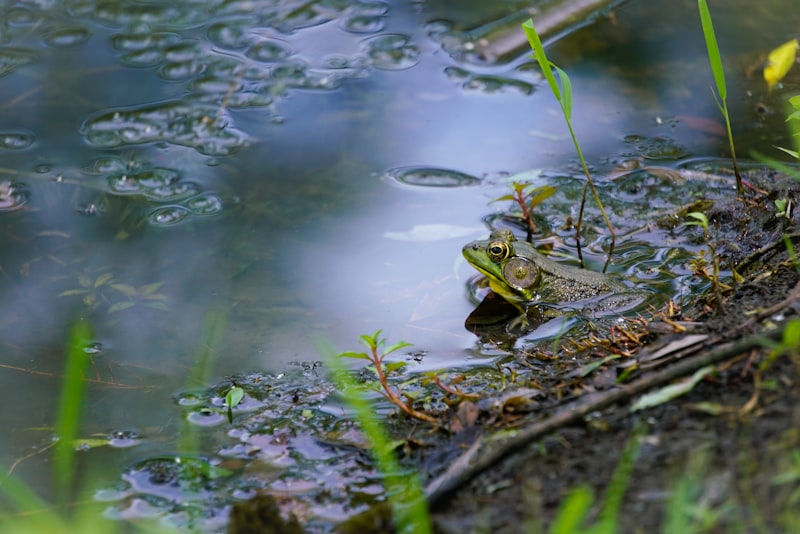Amphibians, those remarkable creatures straddling the line between land and water, showcase some truly bizarre adaptations and behaviors that fascinate scientists and nature enthusiasts alike. From the flamboyant axolotl to the elusive purple frog, these creatures defy expectations with their unique traits.
One of the most intriguing adaptations among amphibians is their ability to breathe through their skin. Unlike humans who rely solely on lungs, amphibians like frogs and salamanders can absorb oxygen directly from the environment through their moist skin. This remarkable adaptation enables them to thrive in both aquatic and terrestrial habitats.
Behaviorally, amphibians exhibit a diverse range of strategies for survival. Take the Surinam toad, for instance, which carries its eggs embedded in holes on its back until they hatch into fully-formed young. This method of brooding is highly unusual among vertebrates and showcases the lengths to which amphibians have evolved to ensure the survival of their offspring.
Another fascinating aspect of amphibian behavior is their incredible metamorphosis from aquatic larvae to terrestrial adults. Frogs, for example, start life as tadpoles—breathing underwater with gills—but undergo a complete transformation as they develop legs, lose their tails, and transition to breathing air as adults. This process exemplifies nature’s ability to adapt and thrive in various environmental niches.
Amphibians are not only strange but also incredibly adaptive creatures. Their unique adaptations like skin breathing and diverse behaviors such as parental care through back-brooding highlight their evolutionary success. Understanding these adaptations not only enriches our knowledge of biodiversity but also underscores the importance of conserving these remarkable animals and their habitats.
Masters of Disguise: How Strange Amphibians Use Camouflage to Survive
Take the mossy frog, for instance. Found in the dense rainforests of Southeast Asia, this frog sports a coat of green and brown patches that mirror the moss-covered rocks and branches where it dwells. When danger lurks, it freezes, becoming indistinguishable from its surroundings. It’s like nature’s own disappearing act!
Then there’s the Surinam toad, a creature straight out of a sci-fi flick. Living in murky waters of South America, this toad looks like a dried-up leaf, complete with ridges and bumps that mimic veins. As it lies motionless on the riverbed, unsuspecting fish swim right into its trap, making it a true ambush predator of the aquatic world.
Moving to the desert, where the painted reed frog reigns supreme. This tiny amphibian from Southern Africa changes its skin color from bright green to sandy brown depending on the surface it sits on. It’s not magic; it’s adaptation at its finest. By blending in, these frogs stay hidden from hungry birds and thirsty lizards prowling the arid landscape.
But perhaps the most astonishing of all is the mimic octopus, although not an amphibian, it’s worth a mention. Found in the Indo-Pacific seas, this cephalopod doesn’t just change color; it mimics the shape and behavior of other marine creatures. Need to look like a lionfish? No problem. How about a flatfish? Easy peasy. It’s a shape-shifting superstar that avoids predators and catches dinner with equal finesse.
In a world full of hunters and prey, these amphibians prove that sometimes, invisibility is the best survival strategy. They remind us that nature’s palette isn’t just for beauty—it’s a survival kit, perfectly designed to keep the balance between life and lunch.
From Gills to Lungs: Evolutionary Wonders of Strange Amphibians
Have you ever wondered how some creatures transition from underwater dwellers to air-breathing land conquerors? Let’s dive into the evolutionary marvels of amphibians, where adaptation has shaped some of the most intriguing species on Earth.
Amphibians, such as frogs, newts, and salamanders, are known for their dual lifestyle, thriving both in water and on land. But what’s truly remarkable is their evolutionary journey, particularly their shift from relying on gills to developing lungs.
Imagine this: millions of years ago, ancient amphibians roamed the Earth with gills, akin to modern-day fish, extracting oxygen from water. However, as habitats changed and opportunities arose on land, these creatures faced a challenge. How to breathe air while still being able to function in water?
Nature had a solution up its sleeve: the gradual development of lungs. This adaptation allowed early amphibians to venture onto land, explore new territories, and find food sources beyond aquatic realms. It was a game-changer in the evolutionary playbook, paving the way for life to diversify and flourish in novel environments.
Take the axolotl, a living relic of this evolutionary tale. Found in lakes around Mexico City, this amphibian retains its larval features into adulthood, including external gills. It serves as a living link to our distant past, showcasing how amphibians have adapted and survived through ages of environmental change.
Moreover, amphibians like the lungless salamanders of North America’s forests demonstrate that evolution isn’t a one-size-fits-all process. Some species have even evolved to breathe through their skin, a testament to the diversity of adaptive strategies within this class of animals.
Bizarre Behaviors: Unusual Mating Rituals Among Strange Amphibian Species
In the heart of Panama’s rainforests, the Panamanian golden frog dazzles with its vibrant colors and elaborate dance routines. Males vie for attention by performing intricate foot-flagging displays, signaling their fitness to potential mates. This ritual isn’t just for show; it’s a testament to their resilience in a challenging environment.

Across South America, the Surinam toad’s mating ritual takes a macabre turn. Females are attracted to males capable of carrying their eggs. Once fertilization occurs, the male embeds the eggs into the female’s back, where they develop into tadpoles before emerging as fully formed toads. It’s a haunting yet effective strategy evolved to protect offspring from predators.
In Australia, the male marsupial frog doesn’t rely on traditional calls to attract females. Instead, it carries its tadpoles in pouches located on its thighs. This adaptation ensures the male’s direct involvement in nurturing the next generation, showcasing a remarkable role reversal in parental care.

These examples illustrate how amphibians have adapted to diverse ecosystems, using unconventional methods to ensure reproductive success. Their behaviors challenge our understanding of courtship and highlight the intricate balance between survival instincts and evolutionary pressures.
From the lush rainforests of Panama to the arid deserts of Australia, amphibians continue to captivate scientists and enthusiasts alike with their astonishing mating rituals. Each species’ unique strategy underscores the resilience and adaptability essential for survival in the wild.
Surviving Extremes: How Strange Amphibians Adapt to Harsh Environments
Imagine a world where life thrives in the most unexpected places, where amphibians not only survive but thrive in the harshest of environments. From scorching deserts to icy tundras, these remarkable creatures have evolved unique adaptations that allow them to conquer extreme conditions.
One of the most incredible feats of adaptation is seen in the wood frog (Rana sylvatica). Found in the northern regions of North America, this amphibian has a surprising ability to withstand freezing temperatures. During winter, as temperatures plummet, the wood frog’s body produces a natural antifreeze-like substance. This allows it to enter a state of suspended animation, where its heart stops beating, and almost 70% of its body freezes solid. Come spring, as temperatures rise, the wood frog thaws out and resumes its normal activities as if nothing happened.
Similarly, the axolotl (Ambystoma mexicanum), often referred to as the “Mexican walking fish,” showcases another extraordinary survival strategy. Native to lakes around Mexico City, the axolotl retains its larval features throughout its life, a phenomenon known as neoteny. This unique trait enables the axolotl to regenerate lost limbs and even parts of its brain. In its natural habitat, where water conditions can fluctuate drastically, this ability to regenerate is crucial for survival.
Moving to the depths of the Amazon rainforest, one encounters the glass frog (Centrolenidae). Named for its translucent skin, this amphibian has evolved to blend seamlessly into its leafy surroundings. Its transparent skin provides exceptional camouflage, making it almost invisible to predators and allowing it to evade detection while it rests during the day.
The adaptations of these amphibians highlight nature’s ingenuity in the face of adversity. Whether it’s freezing temperatures, fluctuating water levels, or the need to remain hidden from predators, these creatures have developed remarkable strategies over millions of years of evolution. By studying their adaptations, scientists gain insights into how life persists and thrives in the most extreme environments on Earth.
Frequently Asked Questions
What are some peculiar behaviors exhibited by strange amphibians?
Learn about peculiar behaviors displayed by unusual amphibians, including unique methods of camouflage, bizarre mating rituals, and adaptations to extreme environments.
What unique adaptations do strange amphibians have for survival?
Explore the unique adaptations of strange amphibians that ensure their survival in diverse environments. Learn about specialized skin textures for water retention, nocturnal vision adaptations, and respiratory modifications like cutaneous respiration.
Why are some amphibians considered unusual or rare in their behaviors?
Discover why certain amphibians exhibit unique or uncommon behaviors that set them apart. Explore the fascinating reasons behind their rarity, from specialized adaptations to ecological niches, providing insights into their evolutionary strategies and ecological roles.
How do strange amphibians adapt to different environments?
Learn how strange amphibians adapt to diverse environments through unique physiological and behavioral traits that help them thrive in various climates, ecosystems, and habitats.
How do strange amphibians reproduce and care for their young?
Learn about the reproductive strategies and parental care behaviors of unusual amphibians. Discover how these creatures reproduce through unique methods and how they nurture their offspring to ensure survival in their diverse habitats.


